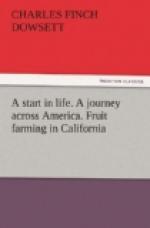The Merced Argus says of raisin culture:—
“One of the great charms of raisin culture is the extreme simplicity of its operations. WHAT CAN BE MORE SIMPLE than to pick a bunch of Muscat grapes from the vine, and lay it on the ground. In six days the bunch of grapes, without being meanwhile touched, has assumed the appearance of a bunch of raisins, and has flattened out as if it had been pressed. It is then carefully turned over, so as to expose the underside to the direct action of the sun. In eight days more it is a perfect bunch of raisins, and no act of man can improve it even in appearance. All the operations of fancy packing are so simple, that a child may learn them in a day. A single acre of raisin vines in a Merced Colony lot means handfuls of bright, golden double eagles to the bright-eyed children of the Merced farmer in the near future.
Harper’s Magazine for January, 1891, contains an article on California, which all persons interested in that State would do well to read. I extract a few statements:—
IRRIGATION.
“A piece of land at Riverside, below the flow of water, was worth 300 dollars an acre. Contiguous to it was another piece not irrigated, which would not sell for 50 dollars an acre. By bringing water to it, it would quickly sell for 300 dollars, thus adding 250 dollars to its value. As the estimate at River side is that one inch of water will irrigate five acres of Fruit land, five times 250 dollars would be 1,250 dollars per inch, at which price water for irrigation has actually been sold at Riverside.
“The standard of measurement of water in Southern California is the miner’s inch under four inches pressure, or the amount that will flow through an inch-square opening under a pressure of four inches measured from the surface of the water in the conduit to the centre of the opening through which it flows. This is nine gallons a minute, or, as it is figured, 1,728 cubic feet or 12,960 gallons in 24 hours, and 1/50 of a cubic foot a second. This flow would cover 10 acres about 18 inches deep in a year; that is, it would give the land the equivalent of 18 inches of rain, distributed exactly when and where it was needed, none being wasted, and more serviceable than 50 inches of rainfall as it generally comes. This, with the natural rainfall, is sufficient for citrous Fruits and for corn and alfalfa, in soil not too sandy, and it is too much for grapes and all deciduous fruits.
“But irrigation, in order to be successful, must be intelligently applied. In unskilful hands it may work more damage than benefit. Mr. Theodore S. Van Dyke, who may always be quoted with confidence, says that the ground should never he flooded; that water must not touch the plant or tree, or come near enough to make the soil bake around it; and that it should be let in in small streams for two or three days, and not in large streams for a few hours.




